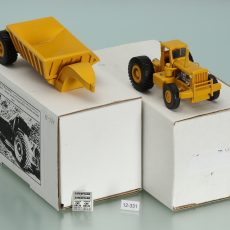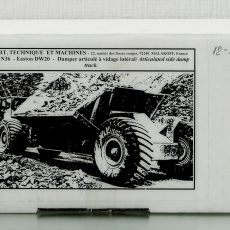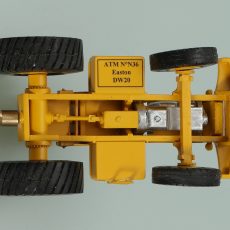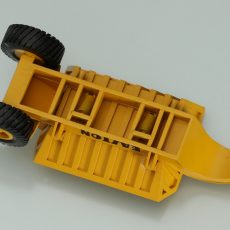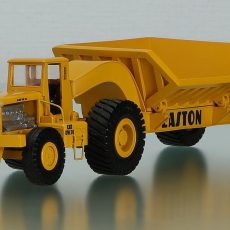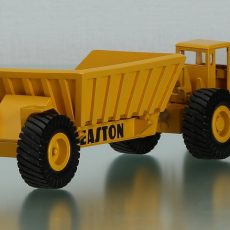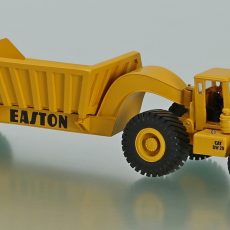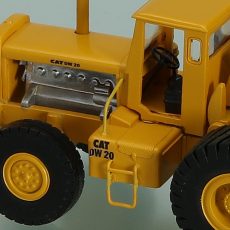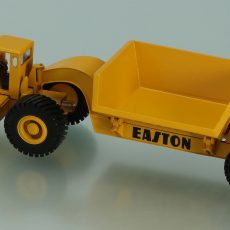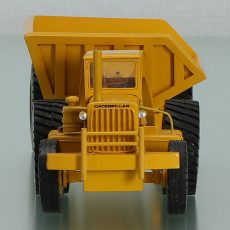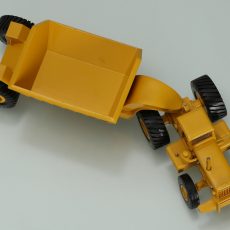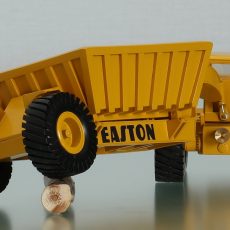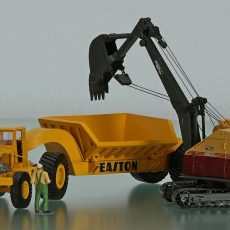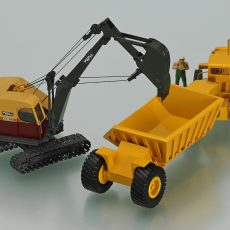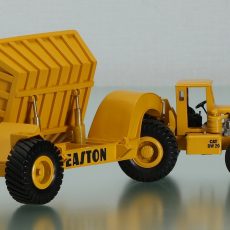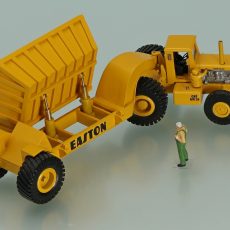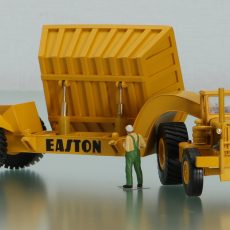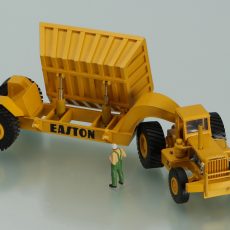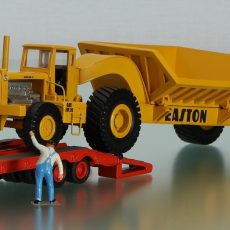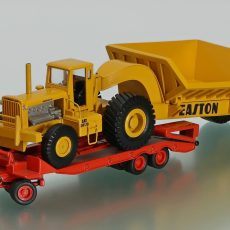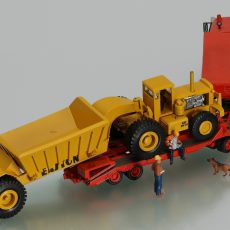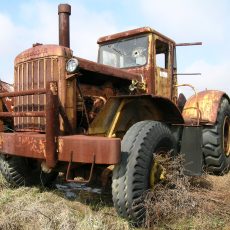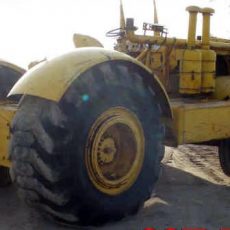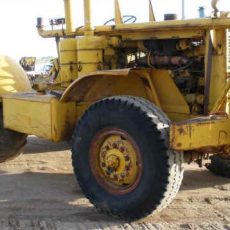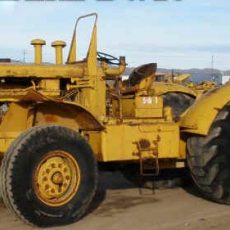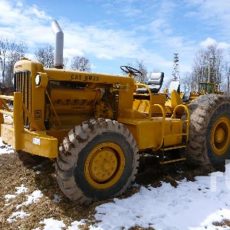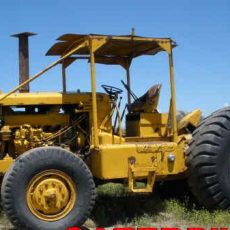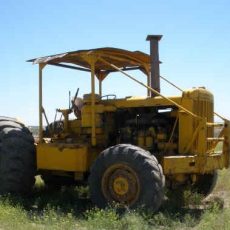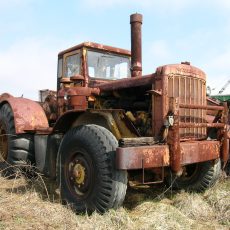Caterpillar DW20 off-road wheeled tractor with Truck semi-trailer Easton
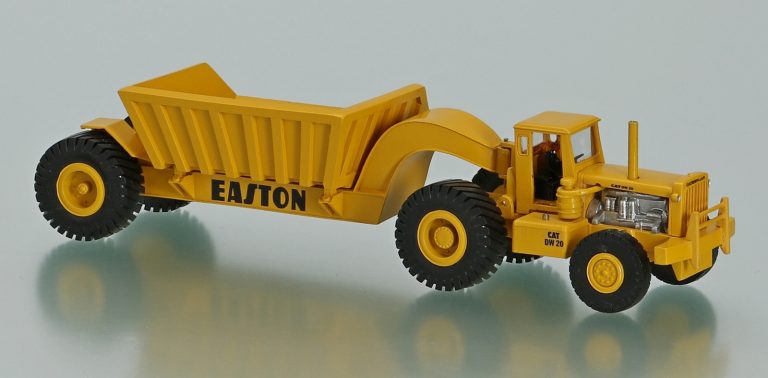
Caterpillar DW20 4х4 внедорожный колёсный трактор с самосвальным одноосным полуприцепом боковой выгрузки Easton ёмк. 15 м3, полнай вес 48 тн, Cat D337 225 лс, 50 км/час, США 1951-55 г. в.
Caterpillar DW20 4х4 off-road wheeled tractor with Truck 1-axle semi-trailer Easton, capacity 15 m3, weight 48 tons, maximum speed 50 km/h.
Engine: Cat D337 225 HP
Manufactured in the USA in 1951-55.
Описание оригинала
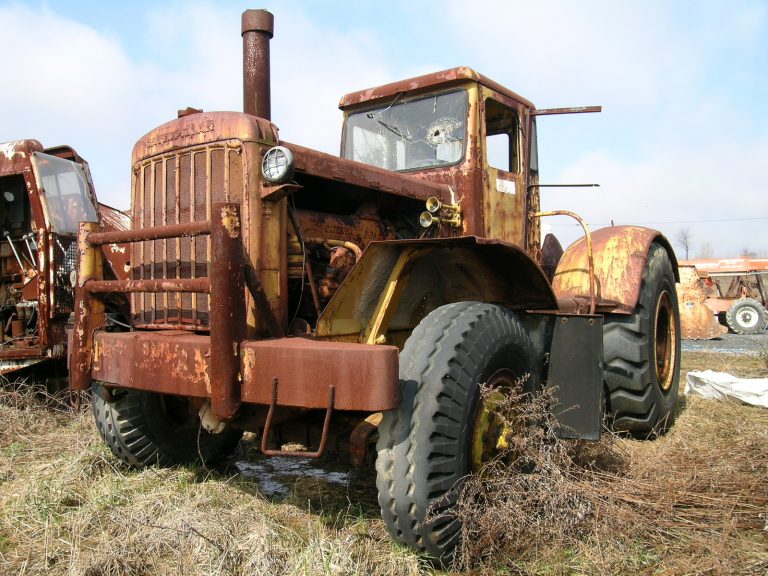
Начало выпуска:
Окончание выпуска:
Файлы
There were six versions of the DW20 manufactured – the 6W series, specifically designed for use with the company’s W20 bottom dump wagon, the 21C, 57C, 67C, 87E and 88E, which could all be used with scrapers or whatever else the customer wanted.
We will not examine the 6W series in this feature as it was basically the same as the 21C series and was purposely built with a dedicated hydraulic system for bottom dumps only.
So, the first of the real scraper tractors was the 21C, originally powered by a Roots blown Caterpillar D337 6-cylinder diesel which was produced from 1951 through to 1955.
Equipped with the Caterpillar No 20 scraper rated at 14 cubic yards struck and 22 cubic yards heaped, this was the model that paved the way for the rest of the series and it underwent a few modifications along the way.
The original 225 horsepower Caterpillar D337 engine suffered from a few cracked cylinder heads due to excessive exhaust back pressure, so a slightly wider cylinder head was designed to alleviate the problem and this incorporated twin exhaust stacks to allow the engine to ‘breathe’ better. This was introduced into the production line as soon as the modified engines became available.
Having cured this problem, Caterpillar also changed the transmission from a 5-speed manual to incorporate an overdrive or auxiliary box function which boosted the machine’s top speed from 26 to 35mph and effectively gave the machine 10 forward gears.
From its inception, the DW20 was fitted with a Caterpillar No 27, 2-drum cable control to handle trailed scrapers. This was a “live-drive” unit powered by a driveshaft that came off the engines PTO. It was rugged and dependable and required infrequent adjustment. It had a line speed of 907 feet per minute and usually used half-inch cable.
By the mid 50s, the DW20 was regarded as a reliable and productive earthmoving tool so it was really no surprise that Caterpillar would want to develop it further.
In 1955 Caterpillar introduced the DW20E which incorporated several major improvements over the previous 21C series machine.
For the first time, customers were given a choice of starting methods – direct electric or the usual 2-cylinder petrol starting engine, which had been a Caterpillar standard since it introduced diesel engines to its machines in 1931.
The DW20E direct electric start version was known as the 57C series and the petrol starting engine version was called the 67C series.
Changes were not isolated to starting methods as Caterpillar had dispensed with the Roots blower, turbocharging the D337 engine which now produced 300 horsepower.
Tubeless tyres were used for the first time, 29.5x29s in place of the old narrow tread, tubed 24.00×29, and an all-new scraper, the No 456, rated at 18 cubic yards struck and 25 cubic yards heaped, became standard.
This proved to be a very popular combination for Caterpillar and it was produced with few changes up until 1958.
Next, and as it proved, last off the production line were the DW20F and the DW20G.
Known initially as the DW20F (87E series direct electric start and 88E series gasoline engine start), horsepower had been given a boost to 320 horsepower and an optional larger capacity scraper, the 24 cubic yard struck, 34 cubic yard heaped No 482 was offered. Use of this scraper required that the machine be tandem push loaded in order to fill the bowl in a reasonable amount of time.
A redesign of the radiator and air induction system produced two recognisable spotting features in the form of twin air cleaners and a radiator header tank that projected above the bonnet line.
For a short time, Caterpillar offered for the DW20 (and DW21) a form of power shift transmission known as “Synchro-Touch”.
This was an electro-pneumatic device whereby the operator dialed in the gear he wanted, depressed the clutch and the transmission would shift without him having to move any levers.
A little too ahead of its time, Synchro-Touch was subject to damage from dirt and condensation which could often result in more gears being selected than required resulting in the inevitable dire consequences for the gearbox.
All machines so equipped were retro-fitted with the standard 10-speed transmission at Caterpillar’s cost and Synchro-Touch was quietly forgotten about!
By yet again increasing the engine output, this time to 345 horsepower, the DW20G was created, the last of the line. Caterpillar chose not to change the serial number prefixes for this modification so the ‘F ‘became a ‘G’ at 87E508 and 88E1261 respectively.
As the DW20 by now had reached the apex of its development potential, and more modern machines were being offered by Caterpillar’s competitors, the DW20 was finally dropped from production in 1960 and replaced with the model 630A.
Specifications – Caterpillar DW20E – 67C series
Engine: Caterpillar D337T, 6-cylinder, turbocharged inline diesel rated at 300 horsepower @ 1800 rpm.
Starting method: Caterpillar 2-cylinder petrol engine rated at 25 horsepower.
Transmission: Caterpillar 5-speed constant mesh with 5-speed auxiliary gearbox giving an effective 10 speeds forward and 2 reverse.
Clutch: Air boosted 16” double dry plate.
Top speed: 33 mph.
Steering: Worm and recirculating ball with hydraulic booster.
Brakes: Air operated shoe type on drive and trailed equipment axles, synchronised to brake trailer first to prevent jackknifing.
Tyres: Front – 14.00×24, 16-ply.
Drive – 29.5×29, 22-ply E3.
Scraper – 29.5×29, 22-ply E3.
Scraper: Caterpillar No 456.
Capacity: 18 cubic yards struck, 25 cubic yards heaped.
Operation: Cable.
Length: 43’ 10”.
Width: 11’ 9”.
Height: 11’ 3½” (to top of apron sheave tower).
Operating Weight: 27 tons (empty), 53 tons (loaded).
Существуют шесть версий DW20 производства – в 6ВТ серия, специально разработанная для использования с фирменной w20 с нижней дампа универсал, 21С, 57В, 67C, 87-е соответственно и 88E, которые могут быть использованы со скребками или то, что хотел заказчик.
Мы не будем рассматривать серию 6W в этой характеристике по мере того как было по-существу этим же как серия 21C и нарочно было построено с преданной гидровлической системой для нижних сбросов только.
Так, первым из настоящих скребковых тракторов стал 21с, первоначально работавший на корнях продуваемого Caterpillar D337 6-цилиндрового дизеля, который выпускался с 1951 по 1955 год.
Оснащенный скрепером Caterpillar № 20, рассчитанным на 14 кубических ярдов, и 22 кубических Ярда, это была модель, которая проложила путь для остальной части серии, и она претерпела несколько изменений по пути.
Оригинальный двигатель Caterpillar d337 мощностью 225 лошадиных сил пострадал от нескольких треснувших головок цилиндров из-за чрезмерного обратного давления выхлопных газов, поэтому немного более широкая головка цилиндра была разработана, чтобы облегчить проблему, и это включало двойные выхлопные трубы, чтобы позволить двигателю "дышать" лучше. Это было введено в производственную линию как только доработанные двигатели стали доступными.
Вылечив эту проблему, компания Caterpillar также изменила трансмиссию с 5-ступенчатой механической на переднюю или вспомогательную функцию коробки передач, которая увеличила максимальную скорость машины с 26 до 35 миль в час и эффективно передала машине 10 передач вперед.
От своего начала, DW20 было приспособлено с Caterpillar No 27, управление кабеля 2 барабанчиков для того чтобы отрегулировать trailed шаберы. Это был” живой привод " с приводом от карданного вала, который выходил из двигателя PTO. Она была изрезанна и зависяща и требовала нечастой регулировки. Он имел линейную скорость 907 футов в минуту и обычно использовал полудюймовый кабель.
К середине 50-х годов DW20 рассматривался как надежный и производительный землеройный инструмент, поэтому неудивительно, что Caterpillar захочет развивать его дальше.
В 1955 году Caterpillar представила DW20E, который включал в себя несколько основных улучшений по сравнению с предыдущей машиной серии 21C.
Впервые заказчикам был предоставлен выбор методов запуска-прямой электрический или обычный 2-цилиндровый Бензиновый пусковой двигатель, который был стандартом Caterpillar с момента введения дизельных двигателей в свои машины в 1931 году.
Версия прямого электрического запуска DW20E была известна как серия 57C, А Версия бензинового двигателя была названа серией 67C.
Изменения не были изолированы к начинать методы по мере того как Гусеница распределила с воздуходувкой корней, turbocharging двигатель D337 который теперь произвел 300 лошадиных сил.
Впервые были использованы бескамерные шины-29.5x29s вместо старого узкого протектора, заглубленного 24.00×29, и совершенно новый скребок, № 456, рассчитанный на 18 кубических ярдов, и 25 кубических ярдов, стал стандартным.
Это оказалось очень популярной комбинацией для Caterpillar, и она производилась с небольшими изменениями вплоть до 1958 года.
Далее, как выяснилось, последние сошли с конвейера были DW20F и DW20G.
Первоначально известный как DW20F (87E серии direct electric start и 88e серии Бензиновый двигатель start), лошадиная сила была дана импульс 320 лошадиных сил и дополнительный скребок большей мощности, 24 кубический Ярд ударил, 34 кубический Ярд нагроможденный нет 482 было предложено. Польза этого шабера требовала, чтобы машина была тандемным нажимом нагруженным для того чтобы заполнить шар в разумном количестве времени.
Перепроектирование радиатора и системы индукции воздуха произвело 2 узнаваемых пятная характеристики в форме твиновских уборщиков воздуха и бака коллектора радиатора который запроектировал над линией bonnet.
В течение короткого времени Caterpillar предлагала для DW20 (и DW21) форму передачи с переключением мощности, известную как “Синхро-касание”.
Это было электропневматическое устройство, посредством которого оператор набирал желаемую передачу, подавлял сцепление, и трансмиссия переключалась без необходимости перемещать рычаги.
Немного опережая свое время, Synchro-Touch подвергался повреждениям от грязи и конденсата, что часто приводило к выбору большего количества передач, чем требуется, что приводило к неизбежным тяжелым последствиям для коробки передач.
Все машины были оснащены 10-ступенчатой стандартной трансмиссией по цене Caterpillar, А О Синхро-Сенсоре было тихо забыто!
Еще раз увеличив Мощность двигателя, на этот раз до 345 лошадиных сил, был создан DW20G, последний из линии. Caterpillar предпочла не изменять префиксы серийных номеров для этой модификации, поэтому " F "стал" G " на 87E508 и 88E1261 соответственно.
Поскольку DW20 к настоящему времени достиг вершины своего потенциала развития, а более современные машины предлагались конкурентами Caterpillar, DW20 был окончательно снят с производства в 1960 году и заменен моделью 630A.

